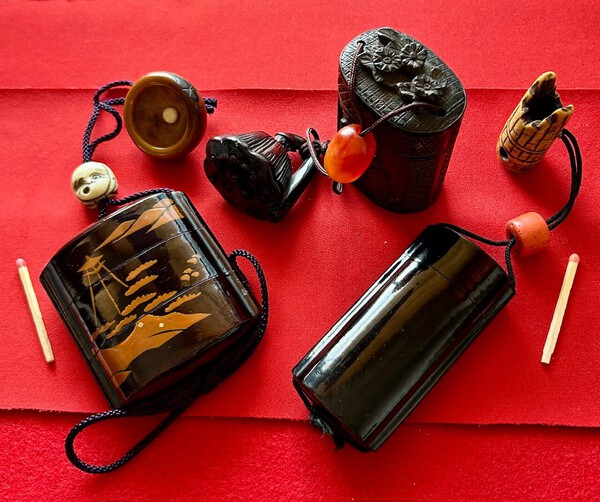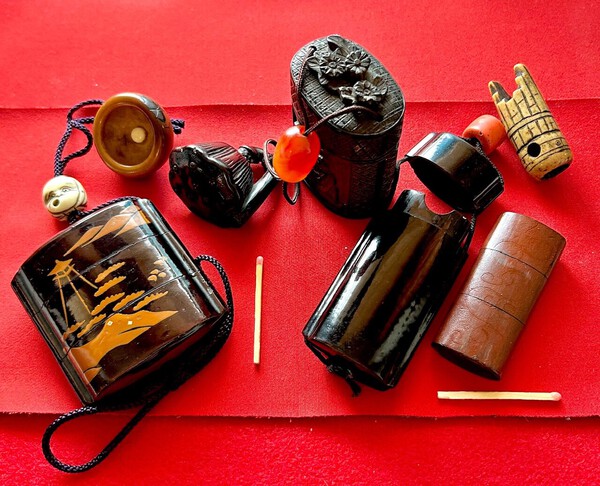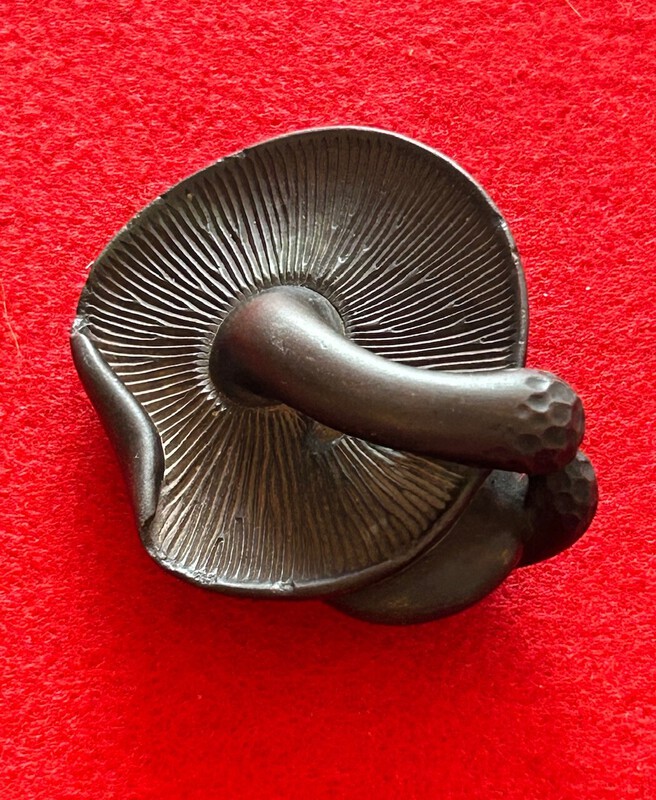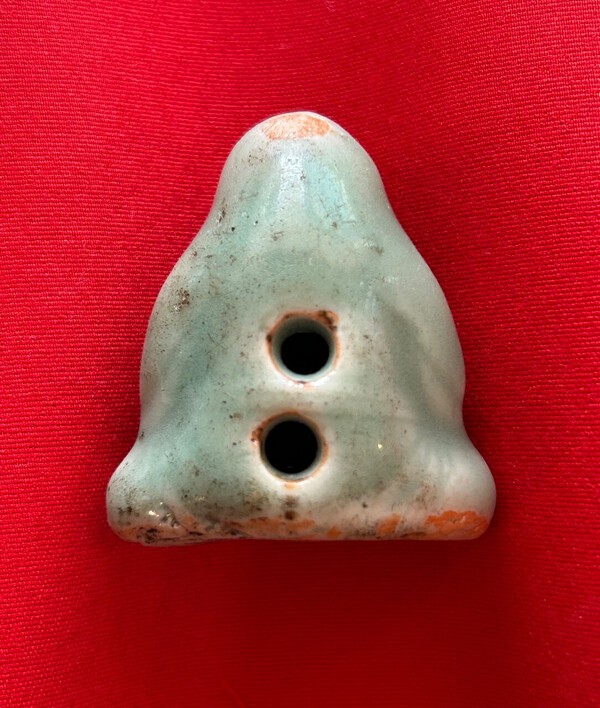-
Posts
14,150 -
Joined
-
Last visited
-
Days Won
265
Content Type
Profiles
Forums
Events
Store
Downloads
Gallery
Everything posted by Bugyotsuji
-
Does that say it 'has a feeling of gansaku Rai Kunitoshi'? 贋作来国俊 Who performed the sayagaki?
-
And here are some children’s (?) miniature inro sets. Note decorative use of various precious metals. Matchsticks for size comparison. And opened
-
A good inro set can be horribly expensive. They were given to the Tokugawa Shōgun, who would in turn give them out to favo(u)red subject Daimyō. Here are three mid-level examples, nothing special, but just for adult size comparison in advance of the miniature ones. One netsuke is a lotus seed pod with rattly seeds, lacquered wood. One is a round ashtray bowl carved from tagua nut, vegetable ivory. On the right is a Shō flute in stag antler. https://m.youtube.com/watch?v=uAdvJMnlj_8 The black inro contains a leather-faced three-drawer medicine container. (Matchsticks for reference) Opened
-
10/12-plate suji kabuto? Many of the features are hard to see, as it's all black lacquer. Does it have shiten-no-byo and hibiki-ana in the four directions?
-
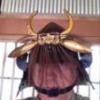
Can't read the number on the torokusho
Bugyotsuji replied to Moritsuchi's topic in Translation Assistance
That's interesting! Thanks, I have never seen one written like that before. -
Yesterday I was round at Igor’s place and he showed me this wonderful heavy book by Ito on Katana-gaké 刀掛, Sword Racks. https://iidakoendo.com/12729/ One thing that caught my eye was that many old sword stands had a special hook for an inro set, called an 印籠掛inro-gaké. Wealthy early to mid-Edo Bushi would remove their sword(s) and their sagemono set (Inro - netsuke - ojime) to be hung on the same rack! This indicates to me how close and valuable they both were to individuals of the warrior class.
-
Diameter is definitely weird. Inconsistency in terms also causes confusion, e.g. 'height' versus 'length'.
-

Can't read the number on the torokusho
Bugyotsuji replied to Moritsuchi's topic in Translation Assistance
For the number of nakago mekugi-ana, it looks like 半 'half' but...are we seeing an old kanji for one? 壱 or 壹 perhaps??? -
Aside from the dropped-and-broken aspect to fired clay netsuke, Richard Silverman amassed a huge collection, cornering the market, which surely increased the rarity of these. Now Colin, perhaps you can better understand my simple joy at spotting that oblong haizara ashtray netsuke some posts above. I still remember the day too when that green Daruma figure appeared on the horizon! By the same token, although rare as hen's teeth, they will never really break the bank.
-
Perfect, Pietro! Many thanks.
-
Please feel free to add comments or examples, and we can go from there. In the meantime I will be mulling over a different angle, such as miniature inro (sagemono) sets, or metal Netsuke, i.e. something just a little different.
-
And finally (for me) a later pottery mask by a well-known maker whose name escapes me. (Need to go back and find those notes.) These fun (upside down) ‘Onko’ Netsuke masks with similarly-glazed eyes can still be found today in various iterations, produced possibly between WWI and WWII. Seal on reverse
-
-
This is a very old Kyoto fired pottery Netsuke possibly around the time of Oda Nobunaga and Toyotomi Hideyoshi, which was broken at some point and lovingly restored with kintsugi. I wrote an article for Euronetsuké a few years back, after discovering that AFE is an old Portuguese word for AVE, faith, likely before the beginning of the banning and persecution of Christians. Naive view of the West? On the back is a water dragon. New World - Old World?
-
Continuing the ceramic theme this is my version of the Kyoto Daruma shown in the catalog posted earlier, maybe even cast from the same mold(?). And the himotōshi holes.
-
This first is one of the seven gods of wealth and good fortune, Daikoku-Ten or Daikoku, with his magic hammer. A crude but genuine still-intact Edo-period Netsuke. View of Uchide-no-Kozuchi hammer
-
Thinking now that I might just clear out this ceramic Netsuke angle by posting a couple more that I found at home recently. Watch this space. In the meantime, Pietro has kindly contacted me and pointed out this excellent visual link to the book on the above-mentioned Silverman collection. Thank you! https://archive.org/details/adornmentinclayc00laur He has also included a link to FaceBook where former collectors from the International Netsuke Society's virtually defunct internet forum now gather. Since I became allergic to F/B many years ago I am missing out by not visiting there. If anyone Facebook-oriented is interested in a serious scholarly group though, please visit there. https://www.facebook.com/groups/netsukes
-
You are right to ask this question, Alexander. May I counter with why you wish to buy over internet auction images? Personally I find myself drawn more to parts of the second example, even if it is not composite.
-
OK, those are great. Thanks Mike. The pan lid (hinged cover) and pin are non-standard but I guess they would perform the role just fine. Nice fluted barrel. I’m thinking somewhere geographically non-mainstream, but without my reference books here I cannot yet pin it down in my mind.
-
There’s a Japanese expression, ‘Oni ni kanabō’ 鬼に鉄棒 Giving a metal club to an ogre means further enabling someone already fearful.
-
松竹梅 Shō-Chiku-Bai, the three symbolizing New Year. (Not sure where they got ‘Masa’ from!) Different museum staff recording at different times. Dale, you could be hired and passed around from institution to institution!
-
Hi Shaun, the scene looks more Japanese than Chinese. Is there a signature at the bottom right? PS Where are those photos stored? There are several easy ways to downsize photos, including using the menu inside your phone camera.
-
The bore is 0.59" which is 1.49 cm, around 5 Monme, originally an army long gun. Many of the crudely scratched numbers will have been notations for the workshop artisans. Can you get overall shots Mike of the gun from the right side and the left side? Might help narrow down where it was made? An angled shot into the pan with vent hole visible might be good too. Do you know exacty where that Yama 山 kanji is located? The underside of the barrel is smooth otherwise?
-
The barrel decorations were probably all added in Meiji, after the end of the Edo Period. It was common then to add a Tokugawa Mon in brass like that, and the single character is likely the ‘Kao’ of the inlay artist. There is a single upside-down 山 Kanji character which means mountain but makes no sense there on its own. Nothing else written under the barrel? There are crudely scratched numbers 二十六 (26) which may be an order run number. The serpentine and lock plate look good. The pan cover is probably a replacement, as too the amaooi rain guard. The priming pan looks a little messed up. Were you able to open the large bisen breech screw? There are various other comments one could make, but some of the most important parts are not visible in those photos. A good study piece!
-

Attempting to roughly ballpark age on a rescued wakizashi
Bugyotsuji replied to NotANinja's topic in Nihonto
There were two Bizen Norimitsu in that time period, with different characters, one 則光 and this one 宝光, but maybe it is 重光Shigemitsu?





